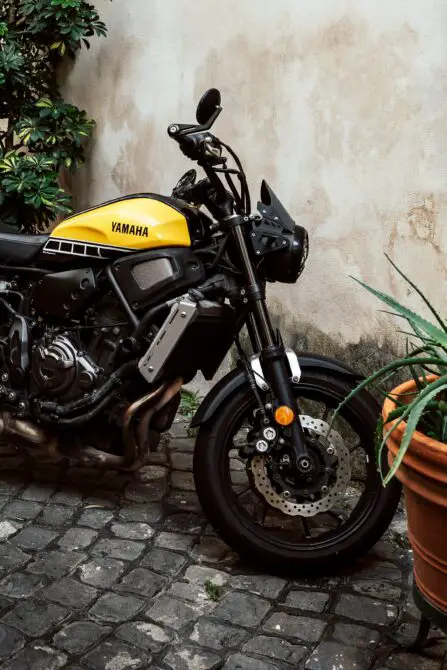Pianos and motorcycles, you say? Does Yamaha make motorcycles and pianos, among other items? Look at it like this. They both make noise and they both offer excitement. And, believe it or not, they share some manufacturing technology.
Table of Contents
- Yes, Yamaha does Make Motorcycles and Pianos!
- Yamaha: In the Beginning
- Yamaha’s First Pianos
- World War I and Harmonicas
- Yamaha Brand in USA
- 1980s and 1990s
- Recent Years
Yes, Yamaha does Make Motorcycles and Pianos!
It’s true, the maker of both products is one of the most diverse companies in the entire world, and its name is Yamaha. It is also the largest manufacturer of percussion and digital musical instruments. But sit down, because that’s not all. Yamaha also makes all the following products:
- Audio products
- Semiconductors
- Furniture
- Sporting goods
- Specialty metals
If this is not enough, Yamaha also has music schools in Japan and 40 additional countries, as well as resorts in Japan. It is also partial owner of the separate Yamaha Motor Company, which makes and markets these products:
- Motorcycles – the world’s second largest producer
- Boats
- Snowmobiles
- Golf carts
- All-terrain vehicles
- Engines
- Robots
Yamaha: In the Beginning
The company was founded in the latter part of the 19th century by Torakusu Yamaha during a time of robust excitement about new technologies and the middle-class inventors who took the technologies and incorporated them into new products.
Yamaha was educated by his well-rounded father who was a samurai, a surveyor, and a man who was fascinated by astronomy and physics. Also, in their home was a comprehensive library which afforded young Yamaha glimpses into all kinds of new subjects.
Yamaha’s first foray into technology came when he studied watch repair in Nagasaki. Soon after, he opened his own watchmaking business, which he had to close due to lack of funds. His next venture into technology was an apprenticeship where he learned how to repair medical equipment. He was sent to a small coastal town to fix surgical equipment. Since the town was isolated, while there, he was asked to repair the town’s beloved reed organ.
A shrewd businessman, he studied how the organ was made and soon crafted his own version. What followed was his own business making organs for schools. At this time, Japan was very interested in Western audiences and so they invested in Yamaha’s fledgling business. By 1889, this grew to become the Yamaha Organ Manufacturing Company, the first manufacturer of musical instruments in Japan and that were targeted at Western musicians. Using what was then the most current mass manufacturing techniques, Yamaha’s company employed 100 people and made 250 organs each year.
Yamaha’s First Pianos

When Yamaha saw that upright pianos were becoming popular in the U.S., he built a new plant that was equipped to make these pianos to sell to the U.S. market. However, some investors pulled out, which meant he had to borrow funds to stay in business. He also changed the name of the company to Nippon Gakki which, when interpreted, means Japan musical instruments. The company manufactured 21 pianos in 1902, including a grand piano. The pianos were made using materials from the U.S. and technology from Germany.
With a goal of getting more exposure, between 1902 and 1920, Yamaha entered his pianos in numerous competitions and won many awards, a new feat for Japanese manufacturers. In fact, one of his pianos won an award at the 1904 World Exposition in St. Louis.
World War I and Harmonicas
During and after World War I, the company began making an easily portable musical instrument: the harmonica. Believe it or not, manufacturing a harmonica required the same technology and materials as a piano. This manufacturing synergy became the guiding principle of the company for the future.
Hard Times
Yamaha died in 1917, and thereafter the company underwent several labor conflict issues. Then came World War I, and with it, a time of booming business for manufacturers in Japan, including Nippon Gakki. Along came 1922 and the company nosedived due to a fire at one of the plants, unfavorable valuation of the yen, an earthquake that destroyed the company’s Tokyo office, and continuing labor strife.
With the appointment of a new president in 1927, the company cut costs and paid off debts and began an upward climb. However, along came World War II and all but one of the company’s factories were destroyed in bombing raids. After the war, and getting back to business, its first products and exports were harmonicas. A few years later, it produced pianos again, using its own metal frames. It was the only piano manufacturer to produce its own frames. Around the same time, it made its very first audio device – the phonograph.
Major Expansion and Diversification
The post-war time was good for Nippon Gakki and the time when it focused on producing products, diversifying its portfolio of products, and cultivating new and foreign markets.
Its expansion and development of new products was mind-boggling. In addition to the musical instruments, in 1960 the company manufactured its first sailboat and went on to make yachts, patrol boats, and ocean worthy fishing boats.
A new material, fiberglass reinforced plastics (FRP), opened new opportunities for other products, including archery bows, skis, and bathtubs. The company’s research into the metals led the way to the manufacturing of products for the household construction industry.
However, pianos were still a key to the company’s overall success, especially since it had discovered ways to make them faster and cheaper than any other piano manufacturers.
The First Motorcycle
It wasn’t until 1955 that Nippon Gakki made its first motorcycle and, at that time, it established the Yamaha Motor Company, Ltd. It was only a partial owner of this enterprise which continued the goal of diversification with the manufacture and marketing of snowmobiles, outboard engines, and golf carts.
Yamaha Brand in USA
Enter the Yamaha brand in the U.S. In the early 1960s, it was the introduction of the company’s first motorcycles to the U.S. that brought the name to America.
Ups and downs continued. Nippon Gakki continued its strategy to open Yamaha music schools, with the first one in the U.S. being opened in 1964. In addition to the ones in the U.S., schools in Japan and Europe fueled the soaring sales of pianos, resulting in the company becoming the world’s largest piano manufacturer.
The next instruments to find a place in the company’s catalog included trumpets, trombones, and xylophones, with the first concert grand piano in 1967. In the meantime, and in order to supply products for its own manufacturing, the company began making electronics components for its digital keyboards. It then became known as an electronics supplier for things like industrial robots.
1980s and 1990s
The 1980s were not kind to Nippon Gakki. Yamaha Motor became aggressive in its manufacturing and marketing and ended up with an enormous inventory of motorcycles. On the other hand, its synthesizers and electronic products did well. Internal management strife resulted in poor decisions that ended up with excess inventory and unprofitable ventures.
New management in the 1990s led the company to design exciting new products, including the Silent Piano series. At $7,300 apiece, and with 17,000 sold in Japan in the first year, the projections for company success were optimistic. This was followed by silent electronic trumpets, Silent Drums, Silent Violins, and Silent Cellos, all of which were wildly popular.
Recent Years
The end of the 20th century saw poor company results due to market conditions, world economies, and an early retirement program. It was back to the core in the early 21st century with renewed focus on musical instruments and audio visual products. A new group was formed to focus on sound chips, digital content for phones and tablets, and the formation of a company that offered music content from downloaded sources,
Pianos are still a key product for Yamaha, and will remain so for the foreseeable future.




